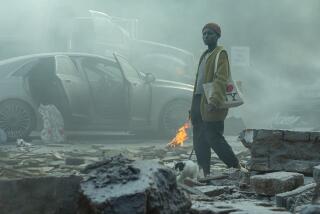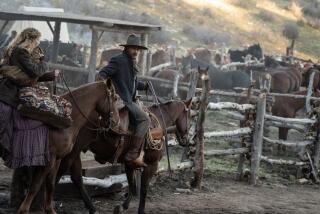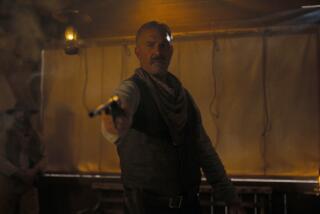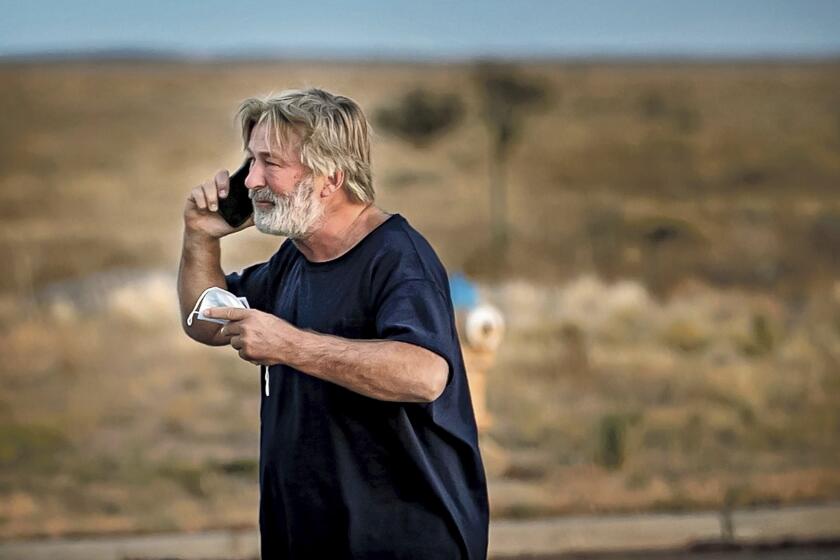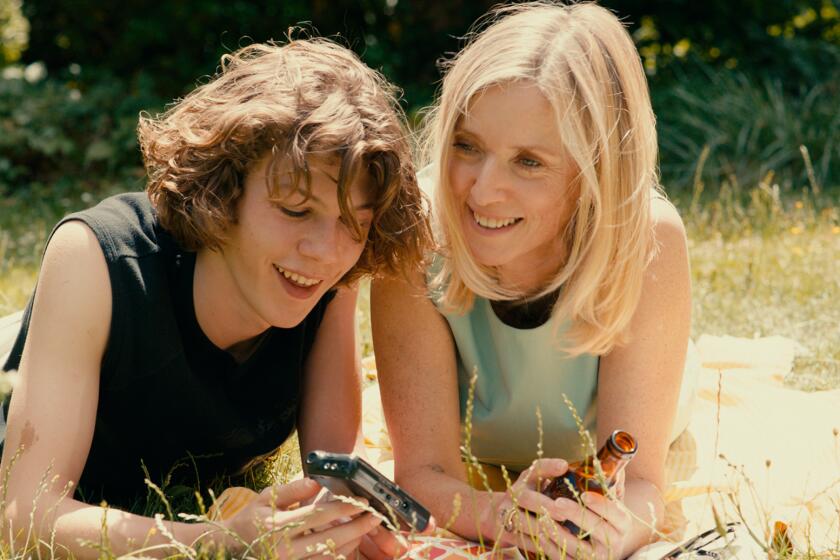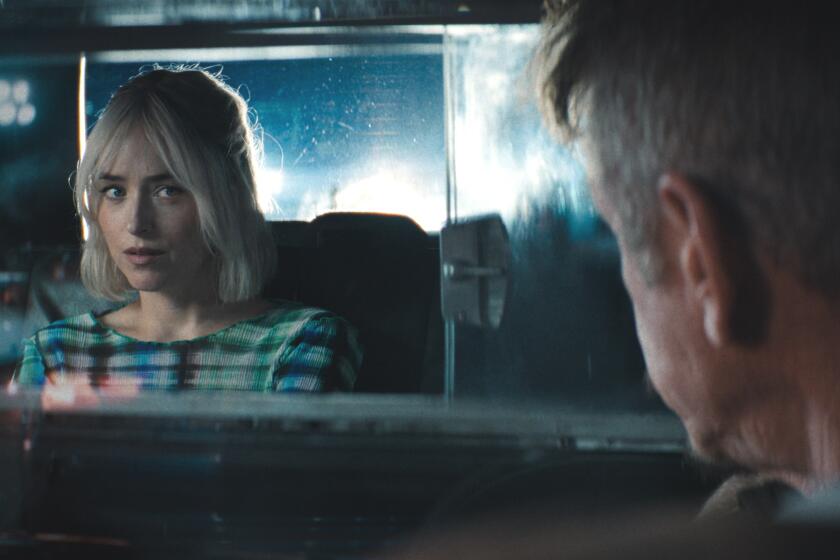MOVIE REVIEWS: 1 MOUSE AND 1 MOTEL : ‘Psycho III’ Still Getting Nourishment From the Original
Welcome back to the Bates Motel, its “No Vacancy” signs lit up for “Psycho III” (citywide).
It’s the same old place: a neat white line of rooms under that dark, crumbling, gingerbread mansion, glowering down from a Universal hillside. There’s even a familiar face: gaunt Norman Bates (Anthony Perkins), the boyish smiler with a knife.
But, over the years, the motel rooms have gotten shabbier, the hinges creakier, the shadows more weirdly bent. It’s a Charles Addams autumn now: A dry, wry wind skirls the leaves and rattles the eaves and windows. Above, Norman argues with his mother: the desiccated mummy, gray gown over bones, whose dusty silver cord still strangles him.
This hell seems to have no particular exit. Perhaps the swamp out back really is a metaphor: the pesthole where more than one movie sequel deserves to sink, bubbling, down into darkness.
Did we need a “Psycho III”? Or, for that matter, a “Psycho II”? Some movies cry out for a sequel. But not Hitchcock’s 1960 classic. It was complete in itself: a psychological tragicomedy tunneling under the bright daylight, a series of mirrors reflecting back blind alleys that twisted in on themselves. It ended with a lot of main characters dead, and the star hauled off to prison or asylum. How do you continue a story like that?
Badly, it seems--despite everyone’s best efforts. “Psycho II” was mostly a callously sexy fun-house, without the awful undercurrents that made razor claws of the original’s humor. But there were so many sleazy slasher movies in between that it looked elegant in comparison, and Perkins’ virtuoso repertoire of tics and twitches carried it further than it deserved.
“Psycho III”--better in most respects than “II”--lets you down with the same swampy thud at the end. It’s not a catastrophe. It has some good writing, and some better-than-good acting (Perkins, Diana Scarwid, Jeff Fahey), directing (Perkins again) and camera work (Bruce Surtees). But it fails any sequel’s acid test: It feeds off the original without deepening it. Could you, in good conscience, run the subsequent “Psychos” on a bill with the first? Wouldn’t they cheapen its memory--despite the obvious respect felt by everyone, including producer and Hitch veteran Hilton Green? (“Psycho III’s” R rating is also for redundancy.)
“Psycho III” is like a gloss on all those critiques on Catholicism, sex, violence and black humor in Hitchcock’s movies. It’s too knowing for its own good. It begins with a parody of “Vertigo’s” climax: a suicidal young nun unwittingly causing an elder to plummet from a bell tower (shot without “Vertigo’s” track-out and forward zoom). Disgraced, the nun, Maureen Coyle (Scarwid)--an “M. C.” like Janet Leigh’s Marion Crane--hits the desert road. There, she’s picked up by a lecherous, L.A.-bound guitarist (Fahey) who paws her, strands her--and then shows up to bedevil her again, when they all wind up (surprise!) at the Bates Motel.
When Hitchcock made “Psycho,” he was deliberately tearing at the audience’s complacency. He wanted to show them terror in a new key: modern everyday horror --superficial reality and latent chaos. That’s probably one of the reasons he shot it in black and white with his television crew. The opening scenes have a quasi-documentary feel; later on, the monochrome becomes a visual motif for good and evil, seen and unseen, moral light and darkness. The sequels, both shot in color, lose all that. They look gruesomely cheerful, and the gushing red blood (which Hitchcock deliberately wanted to avoid) becomes loathsomely showy--the wine of life turned into catsup.
“Psycho III” scenarist Charles Edward Pogue is a clever writer with one interesting notion: contrasting Maureen’s guilt with the dark, vertiginous pull of Norman’s psychological hell, making these two spiritual misfits fall in love. Their paranoid passion crystallizes in one outrageous, eerie shot: Maureen mistakes--in suicidal delirium --the knife-wielding “Mrs. Bates” for a vision of Mary holding a cross. But, shortly afterward, sequelitis takes over and the movie collapses into “Friday the 13th.” Sexy teens show up at the motel, and are killed--in supposedly tense or amusing ways--by Norman in drag. We are expected to chuckle at his consternation as corpses rot in the ice-chest. There’s even some slapstick in the swamp.
The girls aren’t the only victims. The movie dies as well, since its drama comes from Norman’s struggle with his impulses, its comedy from his occasional reminiscences of the monster he once was. These are just obligatory slasher-movie murders, and you’d like to think Perkins was embarrassed shooting them; at least he doesn’t linger over the details.
Despite everything, he shows double talent. Perkins’ directing, like his acting, is full of humor, emotional intensity, chilly clarity and precision: You’d like to see him get more film-making opportunities. But if the movie proves anything, it’s that everyone should give Hitchcock a rest. Like any great master, he can be copied, but never captured--or even really competed with. His movies defy all attempts to leach off them or even pay homage. Their form was too perfect, their fears too personal. The Bates Motel, like many tourist traps, only really flourished under its original proprietor.
‘PSYCHO III’ A Universal release. Producer Hilton Green. Director Anthony Perkins. Writer Charles Edward Pogue. Camera Bruce Surtees. Editor David Blewitt. Music Carter Burwell. Production design Henry Bumstead. With Perkins, Diana Scarwid, Jeff Fahey, Roberta Maxwell, Hugh Gillin.
Running time: 1 hour, 33 minutes.
MPAA rating: R (under 17 requires an accompanying parent or adult guardian).
More to Read
Only good movies
Get the Indie Focus newsletter, Mark Olsen's weekly guide to the world of cinema.
You may occasionally receive promotional content from the Los Angeles Times.
